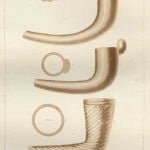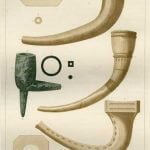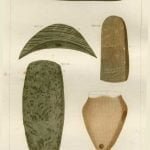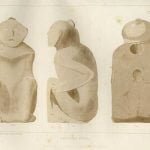
The American Indian takes a great pride in his pipe. There is nothing too precious for him to make it from. His best efforts in ancient sculpture were devoted to it. And there is nothing in his manners and customs more emphatically characteristic, than his habits of smoking.
Smoking the leaves of the nicotiana was an ancient custom with the Indian tribes. Tobacco, which is improperly supposed to be an Asiatic plant, appears first to have been brought to England from the North American coasts by the ships of Sir Walter Raleigh, about 1588. Powhatan and his sylvan court smoked it. It was considered a sacred gift. They affect, in their oral tales, to have received it like the zea maize, by an angelic messenger from the Great Spirit. They offered the fumes of it to him, by burning it in their pipes. This ceremony always preceded solemn occasions. They then partook of the same oblation; and it is well known that they spend a large part of their leisure hours in the pastime of smoking.
It is a custom, which marks them in a peculiar manner. “While it appears to be ancient, there is nothing more fixed in their habits. I have met them in far distant locations, in the wilderness, in a state of want for food, and yet the first request has been for tobacco. So fixed and general a habit would appear to connect itself with their geographical origin. Yet here we are quite at fault.
There is no mention of the custom of smoking in the Sacred Volume. Abraham and Jacob when they were called upon by the duties of hospitality, offered food, but not a pipe or a smoking mixture, to their guests. Job does not mention it. When God says, “it is a smoke in my nose,” it is the fumes of a meat sacrifice that is alluded to. There is, in fact, no allusion to this custom in the Old or New Testament. Herodotus does not name the pipe or smoking. This looks as if it were an occidental custom. We are obliged, in fact, to come down to the close of the fifteenth century, A. D., the discovery of America, for our first knowledge of the Nicotiana, and its uses.
The ancient tribes made their op-wa-gun, or pipe, from various stones yr mineral substances elaborately carved, or from a species of terra cotta. Their graves and tumuli afford specimens of both. The Aztecs employed green serpentine. It is apparent, by the progress of antiquarian discovery that the instrument, as well as the weed, were offered in sacrifice. Some of the western streams have encroached on a species of low mound, disclosing near its interior base a cup-shaped or semi-circular line of hardened earth, which, on investigation, has been found to be a buried hearth or altar, containing innumerable specimens of ancient stone pipes, which appear to have been much altered by fire. Most of these specimens are elaborately carved, representing birds or animals of the country, known to ancient tribes. That these implements had been offered by fire, is conclusively proved by many of them being cracked and burned. The altar is also clearly identified by the deeply hardened strata of loam or earth. Dr. Davis, of Chillicothe, has investigated these altar-mounds on the banks of the Scioto River. Ample descriptions of them are given in the first volume of the Smithsonian Contributions to Knowledge.

The Scioto Valley appears to have anciently borne a comparatively dense population. It is an entire misapprehension to suppose that this was evidence of a highly civilized population. The very custom of smoking, and offering the tobacco plant and the pipe at these altars, a custom so peculiar in itself, is the best proof that the people were of the non-industrial Indian race. What other nation would think of offering on such a rude altar such gifts? We have seen that the oriental world had no such custom. The style of the pipes is indeed elaborate, and bespeaks a proficiency in the art, which is equal to that of the Toltecs or Aztecs. But it is the pipe-sculpture. No article denoting a higher civilization was found. There are evidences that this art of pipe-sculpture was not confined to the Scioto or Ohio valleys. Mississippi and Tennessee, Alabama and Florida, exhibit detached specimens of equally good sculpture in the same article. It has even been found as far north as N. lat. 46, on the St. Mary Straits. ( See Fig. 2, Plate 9.) This sculpture, which is a limestone, represents a lizard. No altar-mounds have been disclosed in these latter States. But these scattered evidences of art, if followed up with skill and assiduity, would probably disclose similar altars in those states. Birds, and not quadrupeds, were generally sculptured.
Of the second species of pipes, namely, the Terra Cotta, there are reasons for supposing it generally of a posterior age.
Short Antique Stemless Pipe Disclosed by the Upturning of an Ancient Tree at Thunder Bay, Michigan

In the month of June 1839, an Indian chief of River Au Sables, named Muk-ud-aie Kain-eiw, or the Black Eagle, presented for my inspection and acceptance an antique pipe of peculiar construction, which he informed me he had found on the main land at Thunder Bay, near the river.
The following drawing ( Plate 8, Figures 1, 2, and 3) exhibits an exact figure of this ancient relic.
The chief informed me that he had obtained it about six or seven feet below the surface of the soil, where it had been disclosed by the blowing down of a large pine, which had brought up by its roots a heavy mass of earth. The tree was two fathoms round at the butt, and would make, he said, a large canoe. With it was found the bones of a human skeleton, and two vases or small akeeks, but so much decayed that they broke in taking them up. In them, besides the pipe, were some of the bones of the pickerel s spine a kind of sharp dorsal process. He saw the thighbones of the skeleton, but the upper part of it appeared to have fallen to decay, and was not visible.
He thinks the tree must have grown up on an old grave, and that the soil must have accumulated on it; an opinion which appears almost inevitable, for there is no other way of accounting so well for the unusual depth.


The pipe, he avers, although so unlike those now employed, was used by their ancestors. It was smoked by clapping the small end to the mouth, without the use of a wooden stem. Pipes of this kind were in use by the old Indians. Thus far the chief.
It consists of a species of comparatively fine-grained, yellowish pottery, resembling the terra cotta, but more slightly baked, and less perfectly tempered.
Subsequent observations, in 1844 and 1845, have disclosed the same species of antique pipe, of various patterns, in the remarkable ossuaries at Beverly, in Canada West; and in ancient graves in Onondaga, Genesee, and Erie counties, in Western New York. The specimens found at the former locality are represented in Plate 8, Figures 5 and 6, and in Plate 10, Figures 1 and 2. Those found in Western New York are depicted in Plate 9, Figures 1 and 3, and in Plate 11, Figure 5. There was also found, among the archaeological relics which are so striking in the area of Onondaga, a beautiful specimen, carved from green serpentine, the locality of which mineral is unknown to mineralogists. (See Figure 4, Plate 9.) The specimen, Figure 4, Plate 8, was found in the collection of Mr. Tomlinson, at the Grave Creek Mound, in 1844. It is elaborately carved from a dark-colored steatite. Numbers 2 and 3, Plate 12, are from the same neighborhood. They evince much skill in the style of carving. Number 3 represents a fish common to the Ohio waters.

Among the fragmentary articles which may be referred to the pipe sculpture and pipe porcelain, are the snake s head, Figure 6, Plate 9, and snake’s body, Figure 5, Plate 9.
The most noted specimen of the prevalent taste for smoking, as well as skill in the manufacture of the pipe, is represented by Figures 1, 2, and 3, Plate 13. This specimen is in the form of an idol, and was smoked from the back, by the adjustment of a stem to the lower orifice depicted in the back. It appears to have anciently stood on some rocks near the old Indian trail leading from the present site of Brownsville, (the Old Redstone,) to the Ohio River, which is struck about twenty miles below Wheeling. This specimen is eleven inches in length, by four and a half broad, and is formed of coarse, neutral-colored sandstone.
